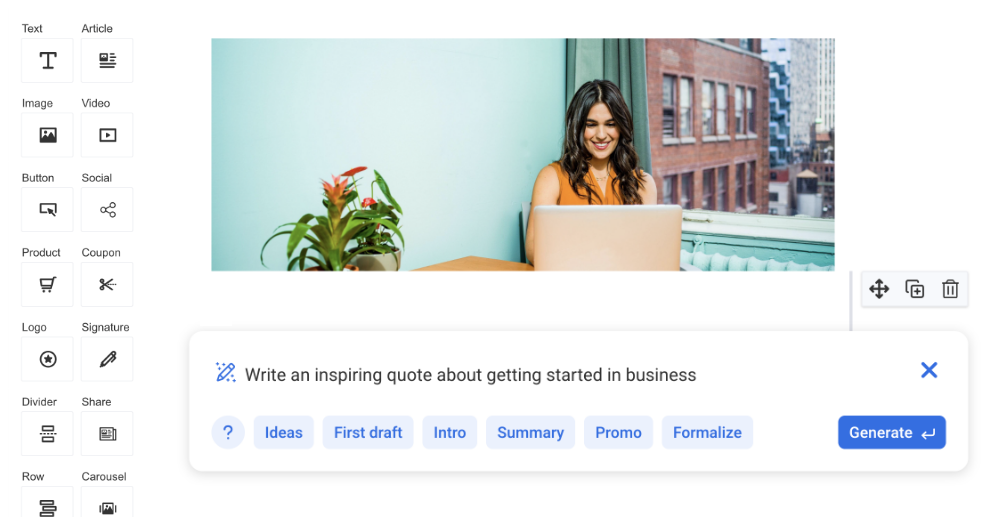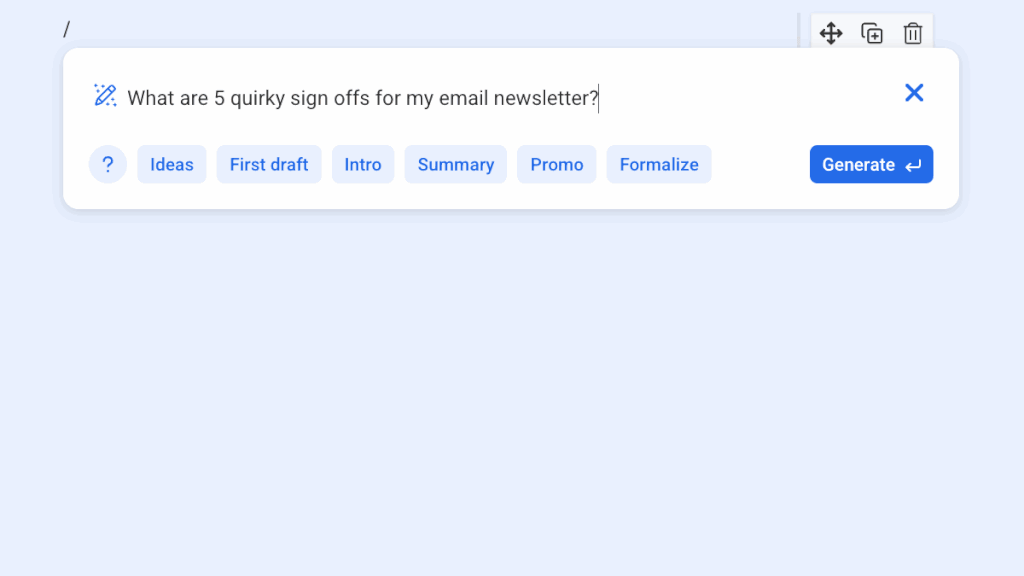How to write AI email marketing prompts that actually work
By Chris Vasquez May 9, 2023
Generative AI is an artificial intelligence that can generate words, images, and more from a prompt. It’s already proving helpful for creators. I find it helpful for everything from coming up with new ideas, translating your own ideas into words on a page, and helping you explore tones or perspectives to communicate.
This is why we built AI writing tools at AWeber,

To be clear, our aim is not to replace human creators – I don’t believe that’s even possible. Instead, we’ve made a tool designed to fill in your gaps so you can create without the frustrating limitations that got you stuck in the past.
Getting started with AI writing can feel daunting. But we’re going to walk through 8 different prompts to help with different stages of the email writing process.
What is a prompt?
A prompt is the text you put into our AI writing tool. The tool will use these instructions to help write your content.

Writing a great prompt is key to getting responses that are interesting and sound natural. Our goal is to build tools where you don’t even have to think about prompts, but it’s a helpful skill to know how to interact with AI models.
If you learn one thing about prompt writing, it should be this:
The more specific the prompt, the better the result.
Including things like your goal, audience, tone of voice, and the length of the response all lead to much better responses.
8 great email marketing prompts
Brainstorm ideas for your newsletter
AI Prompt:
Give me 3 ideas to write about in my newsletter about [add topic]. My target audience is [add target audience]. Avoid ideas about [list of topics you've already covered or find uninteresting].
One of the things AI is most useful for is introducing you to ideas you might never have thought of. We use AI to brainstorm new ways to talk about the things that matter to our audience.
Often times, just a single bullet point idea is enough to get us rolling.
In this prompt you can see that we’re not only telling the AI what we’d like ideas about; but also including topics we want to avoid because they’re boring or we’ve already covered them.
Turn your rough thoughts into an email
AI Prompt:
Simplify this idea into a comprehensible email draft: [Your loose notes]
While testing the AI writing tool with early users, one thing we heard over and over again is how helpful it is to take a great thought someone had and turn it into words in their newsletter.
Let’s face it, we’re not all natural writers. That doesn’t mean we don’t have great ideas, and it shouldn’t block us from sharing those ideas with the world.
This prompt lets you turn a bunch of bullet points or a stream of consciousness series of sentences into something that reads like a cohesive message.
Get a first draft of an email about a topic
AI Prompt:
Write a draft for my email about [add topic with some details]. Include a call-to-action that encourages people to [add action]. Write it to [add target audience] in a [add tone of voice] tone of voice.
I use this one all the time. The funny thing is that I’ve never used the result I get back without substantial edits. It’s still useful for me because it removes a huge barrier: the blank, white screen.
Just having a basic framework is enough to give me momentum, even if I end up rewriting the entire thing.
There are a few things in this prompt that are particularly helpful:
- Including a call to action section forces me to think about my goals for the email, and helps make sure that the rest of the content helps move my readers towards that goal.
- Including a tone helps the response feel more like it’s something I’d actually write.
Create a subject line and preheader for your email
AI Prompt:
Write a subject line and preheader for my email message. It should be intriguing enough to get someone to notice it in their inbox and choose to open it to learn more about what is inside. The subject line and preheader should each be no longer than 50 characters. The email is: [add your email content]
Your subject line and preheader are two of the most important pieces to actually getting your email opened and read.
Through much experimentation, we’ve come up with a subject line generating formula that works great for us.
In this prompt, the AI uses the content of your email to generate a subject line and preheader that work together to make people curious enough to read more.
Get 3 bullet points about a topic
AI Prompt:
Write 3 bullet points that outline [add topic]. Write it to [add target audience] in a [add tone of voice] tone of voice.
This prompt is very helpful for crafting specific takeaways if you already have an interesting hook and lesson to teach.
In one of our newsletters, Sean had a lesson he wanted to communicate and a personal story to make it interesting, but he needed some help thinking through how to communicate specific tactics. This prompt lead him to a number of useful steps people could take to help their own businesses grow.
Create an “ad” for your course or book
AI Prompt:
Write a single paragraph promoting my [product or service]. People who take use it will [add outcomes for customers]. Include a call-to-action that encourages people [add call to action] that focuses on the benefit to the reader. Write it to [add target audience] in a [add tone of voice] tone of voice.
Most of us aren’t natural salespeople. Personally, it sometimes feels like I’m bragging to write about all the great stuff my products can do.
One of the nice things about our AI tool is that it’ll sing your praises without any lack of confidence.
This prompt is designed to help you create simple ad units to promote your knowledge products like courses and ebooks to your audience.
Illustrate a point with your personal story
AI Prompt:
Write a short story for my newsletter about [share personal story]. Relate it to [add call to action]. Write it to [add target audience] in a [add tone of voice] tone of voice.
If your email doesn’t have an interesting hook, most of your audience isn’t going to read it. It’s that simple.
We’ve found that one of the most engaging hooks is a personal story that relates to the lesson you’re trying to teach or thing you’re trying to sell. This prompt helps you take something that’s happened in your life and segue to your lesson or product.
Write an intro paragraph for your email
AI Prompt:
Write a short introductory paragraph for my email about [topic] that will hook my readers so they keep reading. Write it to [add target audience] in a [add tone of voice] tone of voice. The paragraph should introduce this email: [add your email content]
If you don’t have a personal story to start off your email with, this prompt will help you find another interesting hook to pique readers interest and get them invested in your email.
Write a summary to conclude your email
AI Prompt:
Write a 2-3 sentence paragraph for my email that summarizes my thoughts and directs my readers to [add call to action]. Write it to [add target audience] in a [add tone of voice] tone of voice. The paragraph should conclude this email: [add your email content]
Wrapping up an email is one of the most difficult things for me. I’ll either write a massive paragraph that restates everything in the email or I’ll write something that falls flat after all the good content in the rest of the email.
This prompt will help you summarize important takeaways and point your readers at the next steps after reading the email.
How to use AWeber’s AI writing tool
Check out how easy it is to use AWeber’s AI writing tool:
- Open up a draft in the drag-and-drop editor.
- Type “/” to open the menu.
- Select “Write with AI”.
- Enter your prompt and hit “enter”.

 87% off ends soon!
87% off ends soon! 
